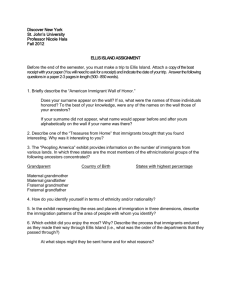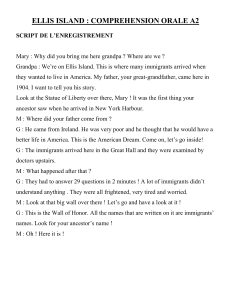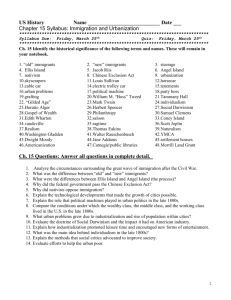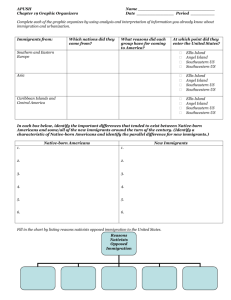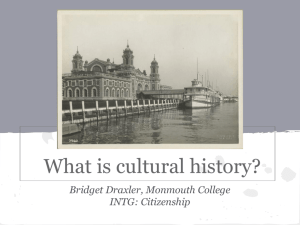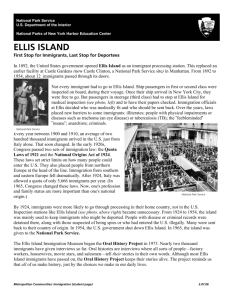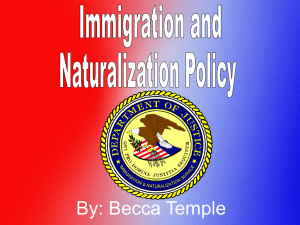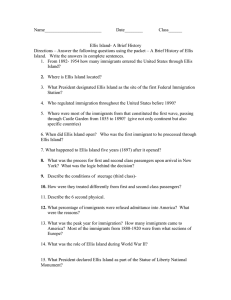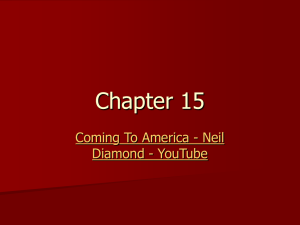Story Lines and Myths in 20th Century Immigration
advertisement
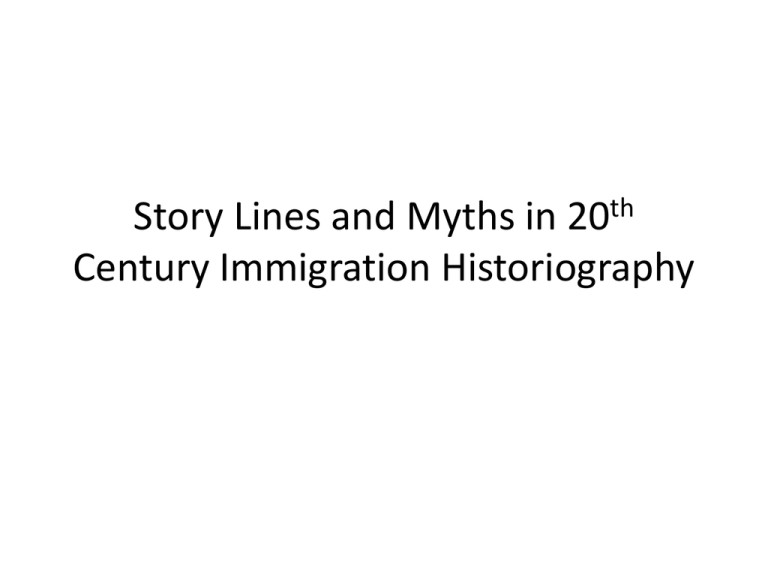
Story Lines and Myths in 20th
Century Immigration Historiography
Opening Comments – Where are
the immigrants?
• Scholarship and autobiography
• John Higham, STRANGERS IN THE LAND
• Mark I Choate, EMIGRANT NATION; THE
MAKING OF ITALY ABROAD
• African Americans
Pre 1790|1790|1820|1880|19
Colonial Period
Early National Period
Middle 19th Century
Immigration High Tide
The “New Immigrants”
Mid 20th Century
Late 20th Century
The General Theory – Push/Pull
Push
Pull
The Mudsill Myth – “La Miseria”
• Difficulties in discerning differences between
those who left and those who stayed behind
• Emigration is a positively selective process
• Motives for emigrating
– Advancing the family economy
– Avoiding conscription or jail
• Social strata of repatriates
– Benestante, Americani, and new Americani
Social Stratification in Franza –
1900 & 1960
Joseph Lopreato, Peasants No More: Social Class and Social Change in an
Underdeveloped Society (1967)
The fallacy of using schooling as a
measure of an immigrant’s worth
• Schooling in 19th and early 20th century Italy
and America
– The significance of this for assessing the character
and resources of emigrants?
– In the U.S. the Common School provided 6 to 8
years of instruction to students
– In Italy village schools offered 3 years [at best]
American Responses to Immigration
• Open Door
– Motivations
• Humanitarian
• Economic
• Restriction
– Motivations
• Economic
• Nativist
History of Nativism
A Case Study of Pull Immigration
The Tirocchi of Providence, RI
A Classic Chain Migration
Origins - Guarcino
Madame Tirocchi
{Anna}
Madame Tirocchi her Butler Exchange
Shop – “A & L Tirocchi” ca 1911
M. Tirocchi with Shop Girls
The new home of “Tirocchi Gowns”
514 Broadway - 1915
Laura Tirocchi-Cella and Dr. Cella
Eugenia Tirocchi – Grocerier and
Landlord
The Tirocchi Men
Frank Tirocchi – padrone, pharmacy
clerk, trucker
Tirocchi Cousins – sand and gravel
merchants, concrete block
manufactures, construction
contractors, tire recapping plant,
auto service stations, dairy plant
and home delivery service,
commercial laundry, etc.
Federico – missionary, parish priest
Ellis Island – The symbol
• 1982 – 1924
– 20+ Million immigrants pass through
Ellis Island
– Peak year – 1907 – 1,004,756 pass
through the station
– 560, 971 enter in 1921
– 1921 Quota Law set nationality limits
for each nationality to 3% of their
number in the 1910 U. S. population
and total annual limit of 358,000
– 1924 Quota Law moved the “reference
date” to 1890 and reduced annual
quota to 164,000
The Ellis Island Myth – “our name was
changed by officials at Ellis Island”
• Time spent and
nature of the
processing of
immigrants at
Ellis Island
– Ship
passenger lists
– Eligibility
screening
– The “six
second
physical”
– Utility of the
Myth
Americanization/Assimilation Theories
• Racial implications of the “new immigrant”
concept
• Red Scare and the intensity of Americanization
efforts
Melting Pot or Salad bowl
The Melting Pot at Ford
Immigrants’ responses to assimilation
• Family economic strategies
–Old or new world locus
•Schooling for children
•Economic choices
•Language and citizenship
decisions – “language loyalty”
The Myth of the Marginal Man
Americanization – Institutions
•
•
•
•
•
•
Schools
Settlement Houses
Industry
Public Libraries
Religion
Ethnic Press
George F. Johnson and the Square Deal
• New employees at Endicott Johnson
were given a copy of a pamphlet
called "An EJ Worker's First Lesson
in the Square Deal."
• It read, in part:
• "To the new EJ worker: You have
now joined the happy family in the
square deal. If you are faithful, loyal,
and reliable, you will earn a good
living under fair conditions. You are
indeed a part of the company.
Remember that you are cared for
when sick, medical and hospital
services are yours, privileges of
many kinds are yours. Your friend,
George F. Johnson."
Religion
• The American “Irish” Church and Immigrants
• “National Parishes”
–
–
–
–
Protestant evangelicals
Italians
Trusteeism
Other Roman Catholic groups – “The Polish National
Catholic Church -1897”
•
•
•
•
Ownership of Church property
Parish government in secular matters by parishioners
Parishioner authority in assignment of Priests
Appointment of Polish Bishops in the U.S. – participation of
clergy and Laity
Schools – Public and Parochial
Chazy Central Rural School
Home Economics
Physical Education
Industrial Education
Adult Education


